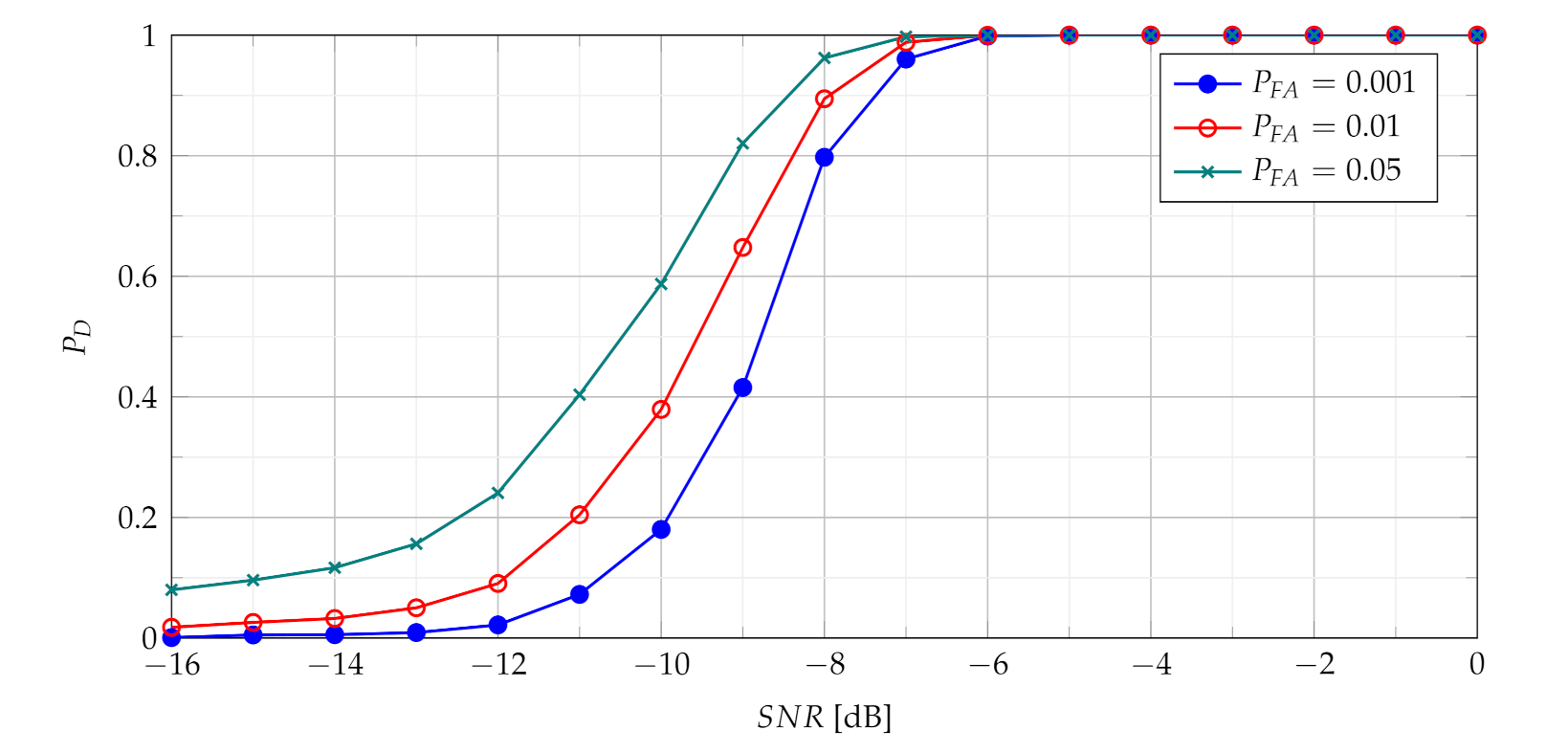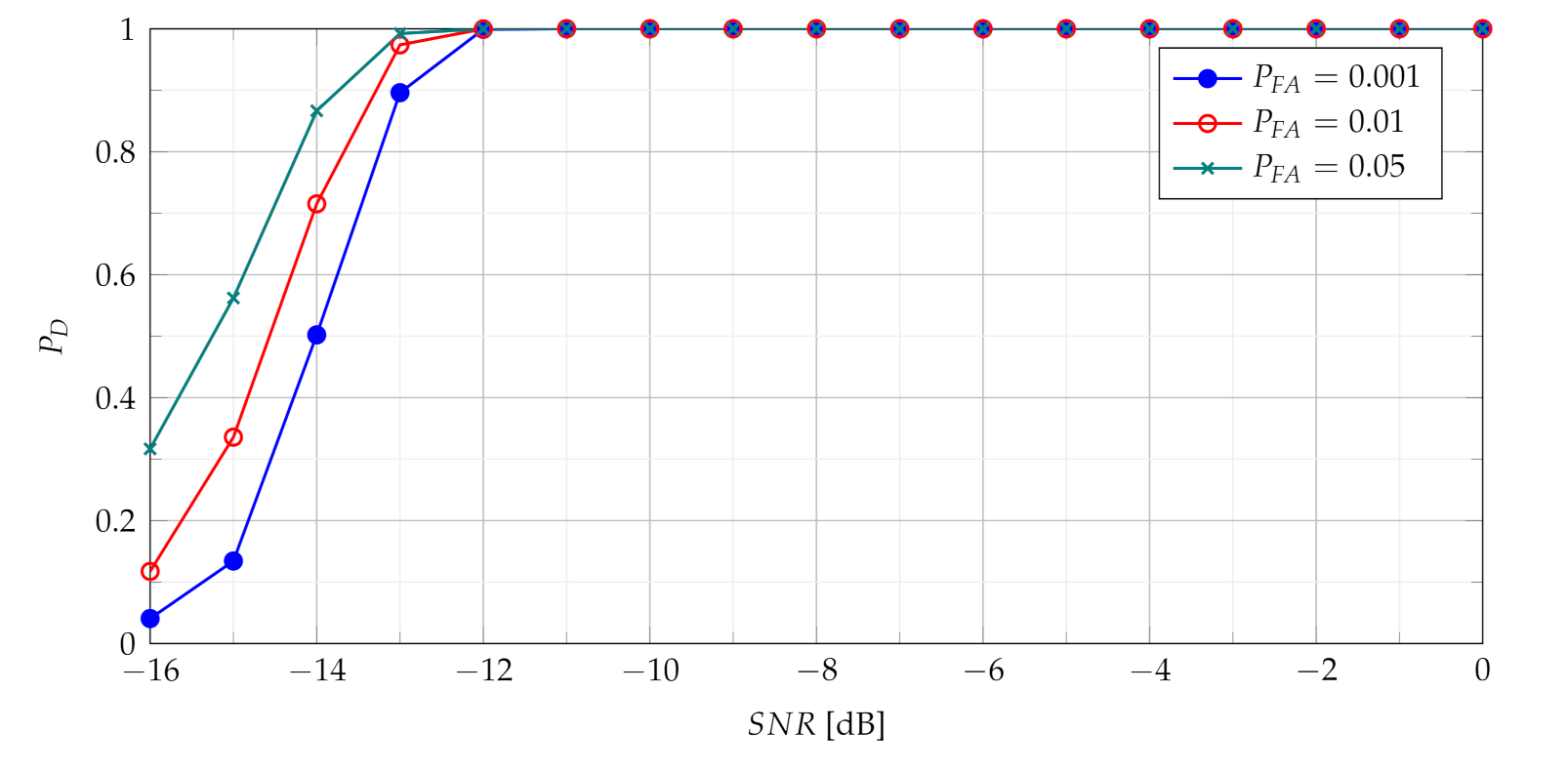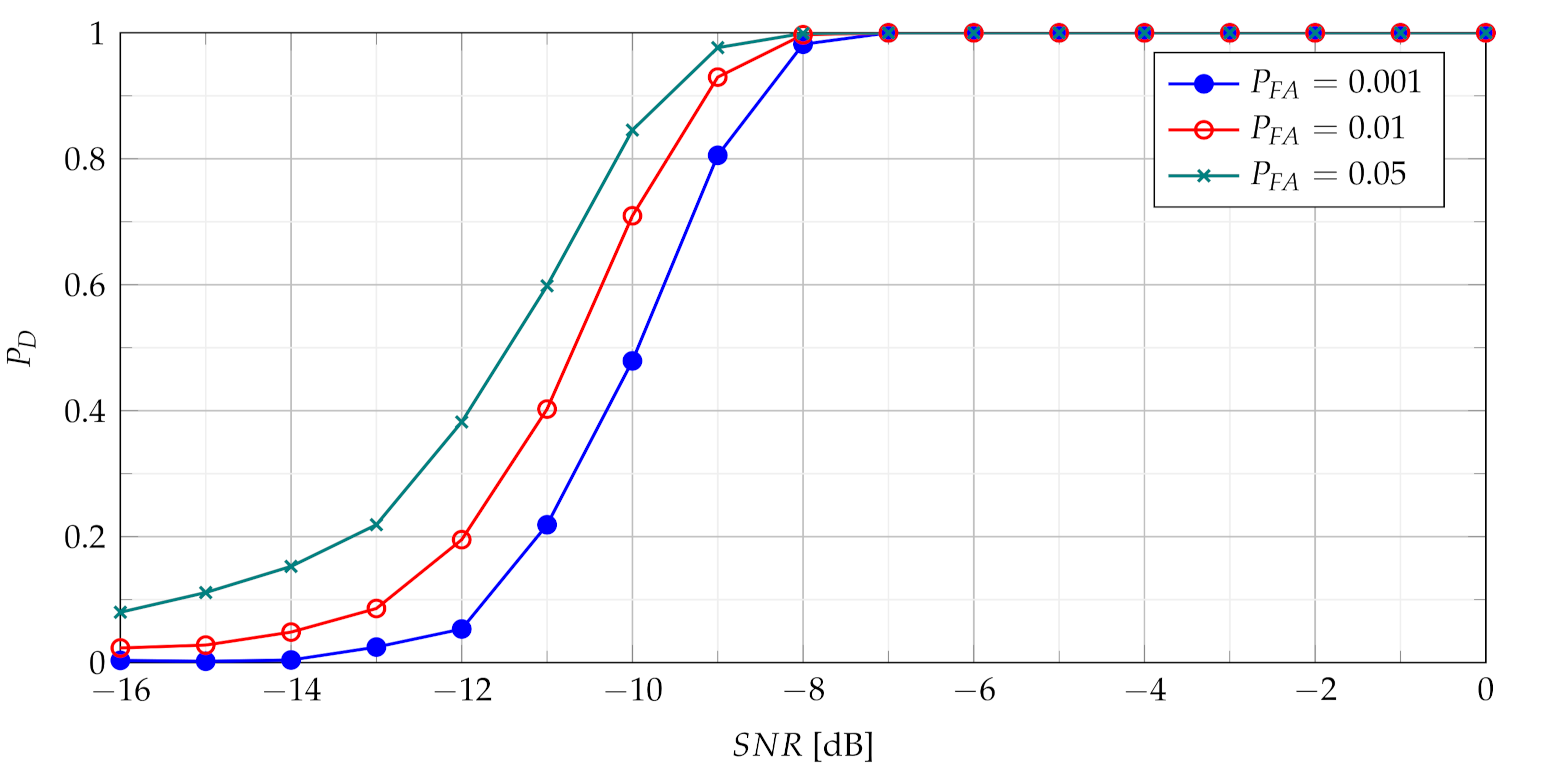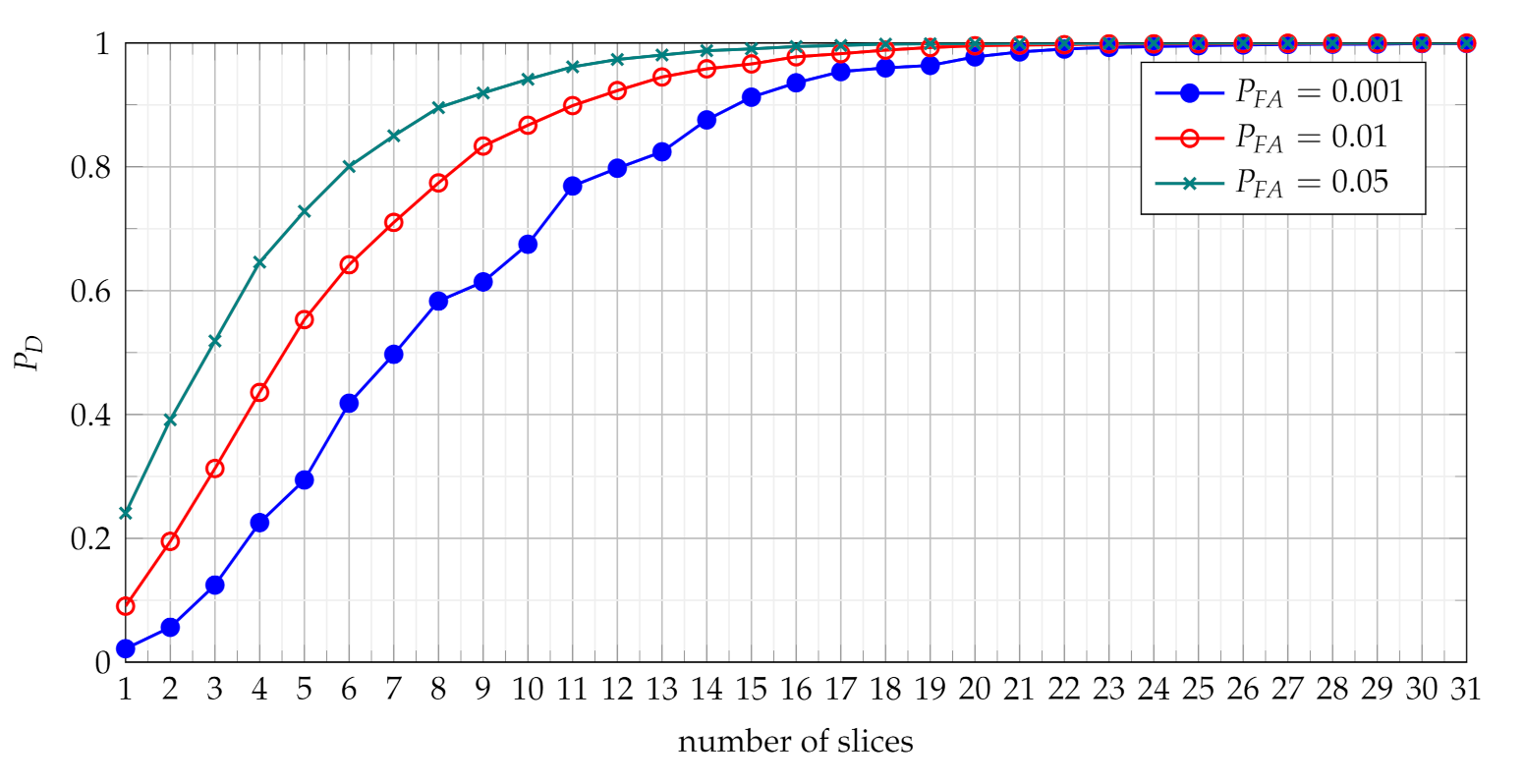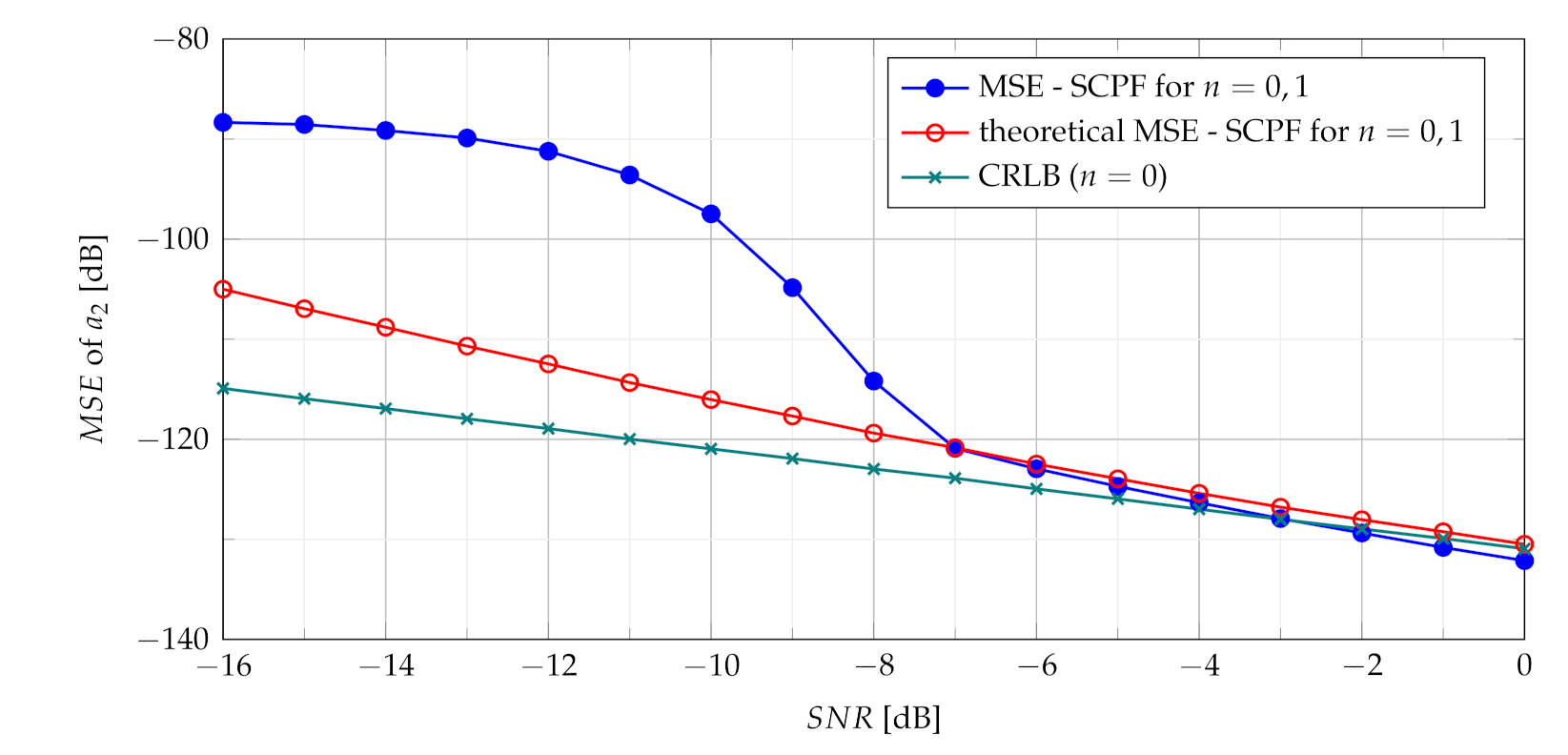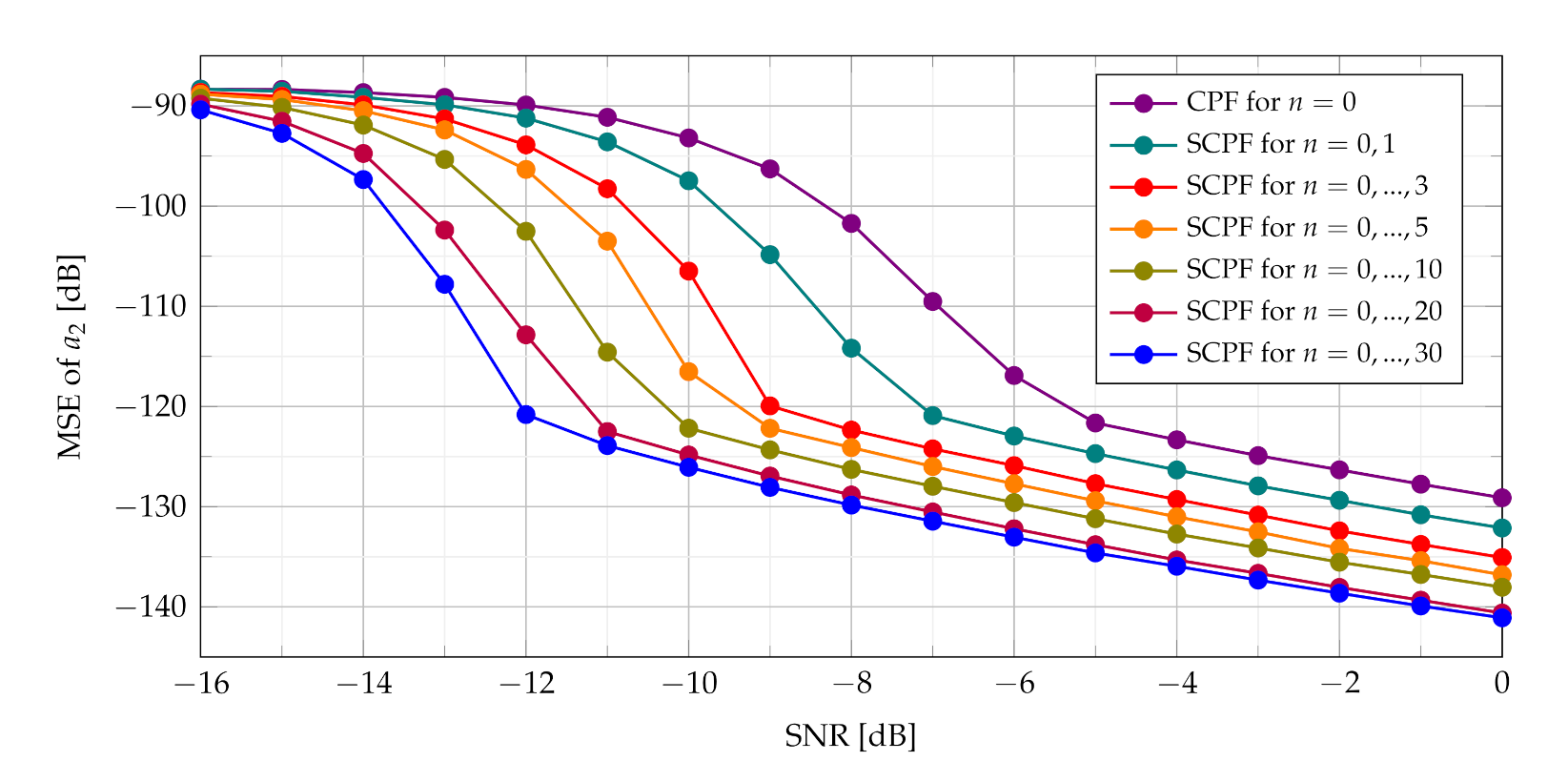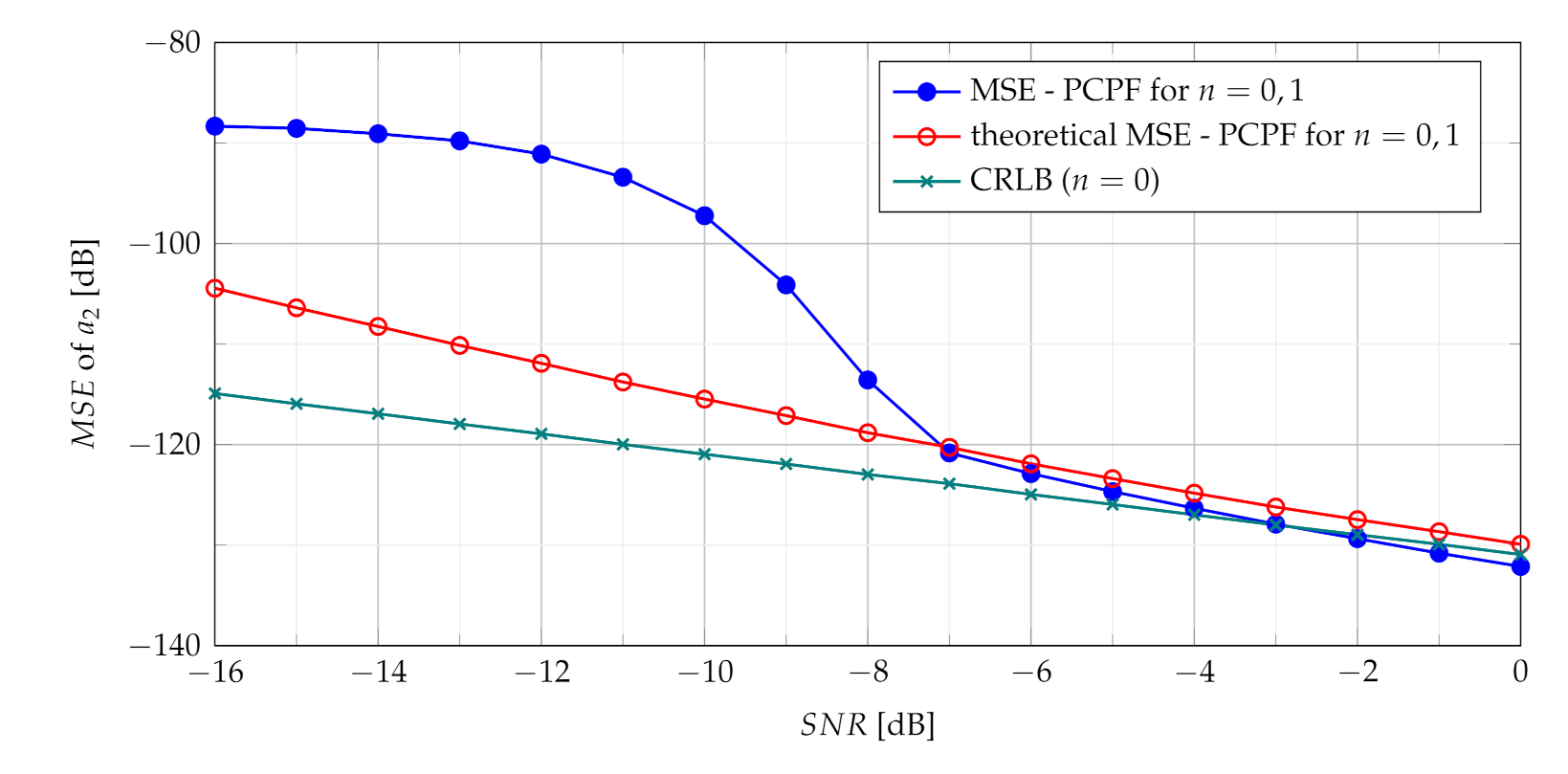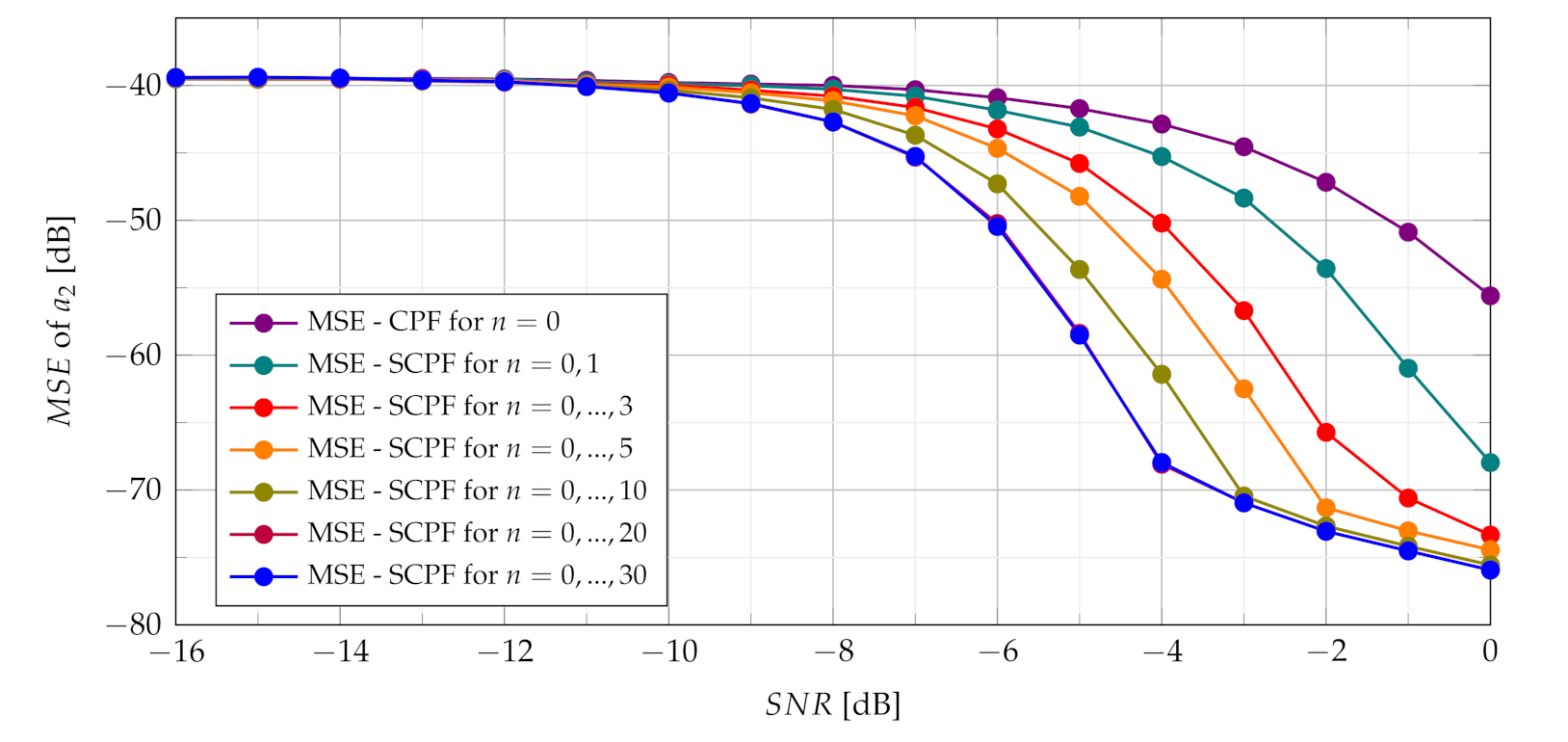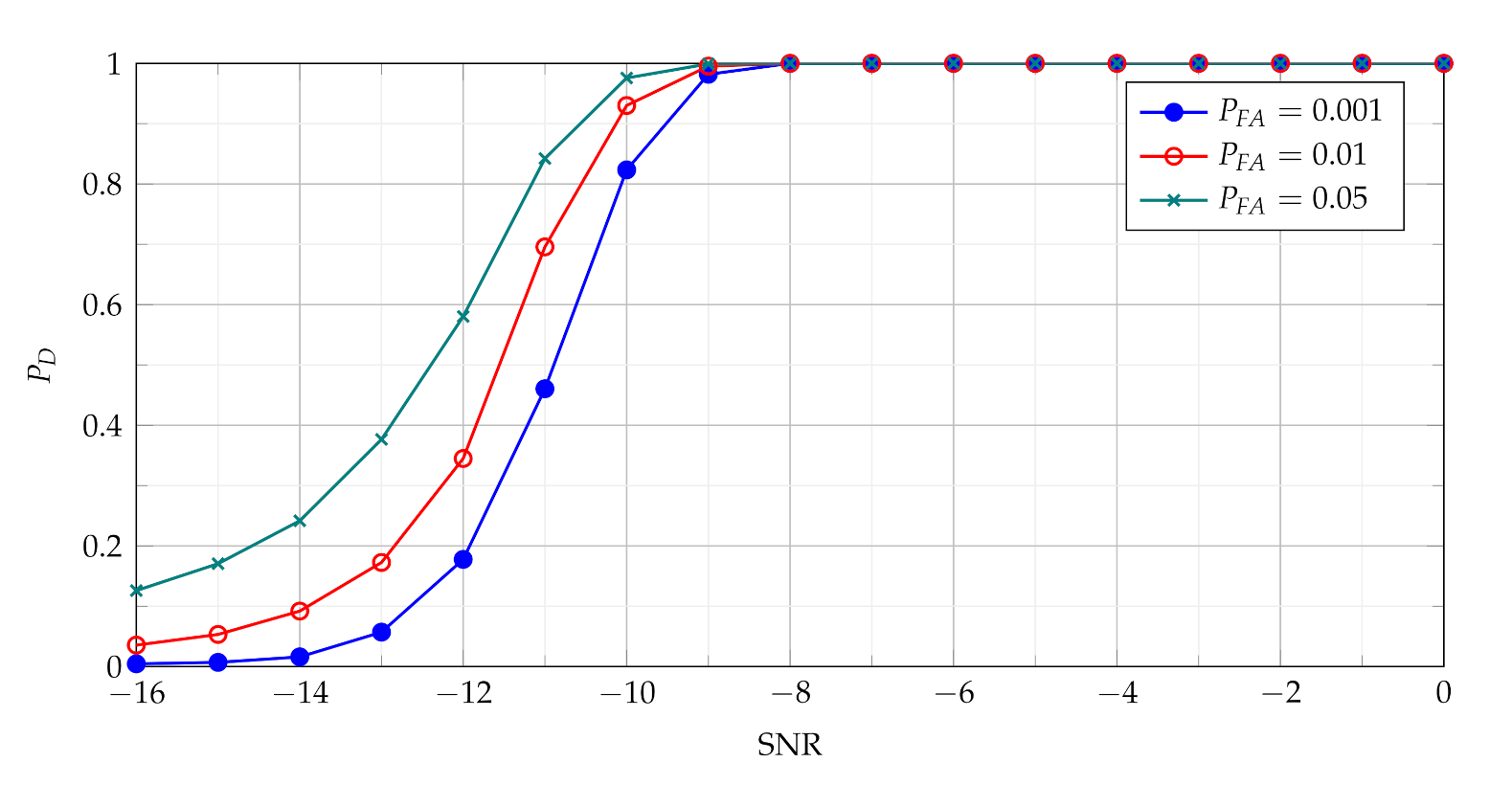2. Problem Statement
The optimal approach to analysis of single-component LFM signals is based on the maximum likelihood estimator (MLE) [
12,
13,
14]. However MLE is ineffective for the higher order polynomial phase signals, due to necessity of solving multidimensional optimisation problem with inevitable high numerical burden.
LFM signals embedded in noise can be described as follows:
where
is a noiseless polynomial phase signals with parameters
and
is complex white Gaussian noise of power
.
The use of MLE approach for the signal
described by (
1) leads to a two stage estimation algorithm where parameters
,
(
is also called CR parameter) are calculated in the following way:
Next, using
in the dechirping process, two remaining parameters
of the signal can be calculated as follows:
There are several suboptimal approaches employed to the problem of parameter estimation of LFM signals. Each of them suffers from method-specific drawbacks but also shows method-specific advantages. The first generation of time-frequency (T-F) methods was based on the high-order ambiguity function (HAF), product HAF (PHAF), integrated generalized ambiguity function (IGAF) [
15]. The chirp-Fourier transform or subspace-based algorithms (e.g., MUSIC and ESPRIT) [
16,
17] due to the non-stationary properties of chirp signals and the high rank of covariance matrix are much less useful than the maximum likelihood (ML) method. A variety of different methods were recommended for the analysis and estimation of LFM signals based on T-F processing for example extended generalized chirp transform [
18]. The WVD and the spectrogram as the square modulus of the STFT show ideally linear dependence of frequency on time for LFM signals in T-F plane. However the STFT transform can be also used in parameter estimation of higher order polynomial phase signal (PPS) with polynomial order
[
19]. Next, the problem of detection and estimation of LFM signals can be solved using image processing methods, so it is reduced to the detection of line in an image, which is an easy-solved problem in pattern recognition [
20,
21,
22]. The Radon-Wigner transform (RWT), the Wigner Hough transform (WHT) and the Radon-ambiguity transform (RAT) detect LFM signals in a time-frequency image by incoherent energy integration of Wigner-Ville distribution or ambiguity function (AF) in the image. Unfortunately these methods are complex and time consuming compared to other known methods such as those based on the chirp-Fourier transform and the MLE [
15,
23,
24]. The Quasi-maximum-likelihood estimator (QML) is an extension of the STFT. In this method, the optimal window is searched in the STFT. Next, the STFT for the optimal window is performed to obtain rough estimates of parameters (including the
parameter) [
25], which are used as initial conditions in the ML procedure. The concept of the complex phase of the STFT results in additional new structures of instantaneous
estimators for LFM signals [
26].
In this paper, LFM signals defined by the polynomial phase of the second order are estimated by methods based on the CPF, which are in time–frequency rate (T-FR) processing domain. Due to nonlinearity in the exponent of the CPF transformation, this distribution cannot be calculated exactly by the Fourier transform, so sub-band decomposition in frequency rate (further denoted as
) domain should be done to reduce a number of operations for the CPF calculation. Instantaneous frequency rate is one of arguments of the CPF distribution whereas instantaneous frequency is an argument of well-known quadratic time-frequency distributions like the spectrogram or the WVD in the T-F plane. Although both the IFR and the IF are denoted by the same symbol
in relevant distributions, they have completely different properties. In general, even for multi-component signal case the IF as the first derivative with respect to time of the phase function can be calculated by the differentiation of the STFT phase. However the IFR as the second derivative of the phase function cannot be calculated by the second derivative of the STFT phase for the same signal [
27,
28]. When a signal is the PPS of the second order (LFM signals), it is possible to estimate IFR i.e.,
in alternative way by analysing peaks of the CPF [
29]. Having had the IFR estimator, all parameters of LFM signals can be estimated. Hybrid CPF extensions such as the CPF-HAF and the high order CPF-Wigner-Ville (HOCPF-WD) [
30] are dedicated to higher order PPS estimation and the
parameter is included in the estimated set of parameters. Another extension called the integrated CPF (ICPF) refers to LFM signals only and offers good properties of IFR estimation [
29].
3. Extended Forms of the Standard CPF
Initially, the CPF was a distribution intended for parameter estimation of quadratic FM signals only, but this distribution can be effectively used for parameter estimation of linear FM signals. The CPF distribution is given as [
25,
31]:
where
is an argument related to the IFR of signals. The IFR is defined in the form:
where
is a signal phase. IFR estimate at time moment
n can be obtained as following [
25,
31]:
so the estimate of the IFR is an argument, which maximises the magnitude of the CPF at each
n.
When computing the CPF formula, the product
is calculated first and for LFM signals this operation results in deterministic (
) and random (
) components:
The expression
is a constant for given
n and represents the ‘initial phase’, whereas the
is a quadratic phase parameter with respect to
m and corresponds exactly to the IFR of a LFM signal. For
, the CPF attains the maximum, for which the
value is the IFR allowing to estimate the chirp parameter
. Then the estimate of
can be found using the Fourier transform
of the dechirped signal
.
Parameters
and
are estimated in the same way as in (
3) and (
4).
The goal of our research is to develop method, which allow to improve performance of the estimation procedure. The objective is detection of LFM signals described by the parameters
,
,
from the noisy observations and estimation of the
parameter, with the accuracy close to the CRLB and with the SNR threshold as low as possible, in low SNR conditions. To achieve the intention, we propose two novel distributions: the SCPF and the PCPF build as extended forms of the standard CPF distribution. We evaluate the use of the SCPF and the PCPF by preliminary theoretical analysis and extensive simulation testing. The proposed extensions rely on the combination (multiplying (PCPF) or adding (SPCF)) of several CPF slices. The term slice is defined as the cross-section of the CPF taken at different time instant
n (as in (
11) and (
12)). This approach results in obtaining new time-frequency rate distributions with different properties than the properties of standard CPF.
where the SCPF is the sum of the CPFs at different time positions
n.
where the PCPF is the product of the CPFs at different time positions
n.
It is expected that the multiplication and summing operations will amplify auto-terms of a signal and suppress the noise component which would decrease the Signal-to-Noise threshold (SNR threshold), under which the estimation process exhibits a rapid deterioration of estimation accuracy. It can be easily noticed that the extended forms show the same location of a peak related to the
parameter as in the CPF. The CPF-based estimator for
estimation is statistically efficient, since its mean squared error (MSE) asymptotically approaches the Cramer–Rao lower bound (CRLB) at high SNR at
[
25]. It is anticipated that extended estimators SCPF and PCPF of the
parameter will reveal good statistical properties at much lower SNR threshold values than the CPF-based estimator. The estimation process of the
parameter can be reformulated as the detection of LFM signals with the set of parameters
in an observed signal, therefore the procedure of searching IFR spectrum peaks, which exceed the detection threshold level is proposed in the detection stage.
4. Detection of LFM Signals with Using CPF-Based Detectors
The issue of detection of LFM signals can be solved with use of binary hypotheses testing with two hypothesis (
and
) on absence or presence of a signal in noise background formulated as following:
The CPF-based detection procedure compares the highest peak of test statistics the
and
,
proposed by authors with the threshold
. The thresholds can be calculated based on Neyman-Pearson criterion with assumed probability of false alarm (
).
Due to the fact that test statistics are non-linear, the Monte Carlo simulations are used to determine the probability of signal detection for a given . The proposed detection method of LFM signals is equivalent to estimation of their CR ( parameter).
The concept of signal detection and estimation of its parameters using the CPF is shown in
Figure 1, where two CPF realisations are presented for the up-chirp LFM signal with bandwidth
kHz and parameters:
,
,
,
. These parameters are also used in simulations presented in the
Section 6. Two cases with SNR = 0 dB and SNR =
dB are shown. The position of
for which the CPF magnitude achieves the maximum value (
) is searched. This position points out the estimated value of
parameter as follows [
29]:
For a noiseless signal or signal with the high SNR (as can be seen in upper part of
Figure 1), the maximum of the
clearly indicates the
value for which this maximum occurs. However for low SNR values, the maximum may be ambiguous as presented in lower part of
Figure 1.
The flowchart of the parameter estimation can be summarised in the following way:
calculate the CPF distribution (according to (
5));
calculate the SCPF or the PCPF distribution (according to (
11) or (
12));
take the
value obtained from maximum value of the SCPF or the PCPF magnitude and calculate estimate of
parameter (according to (
18));
moreover,
estimate could be obtained in the classical way by searching maximum in Fourier spectrum after signal dechirping with use of
, whereas
and
could be calculated according to (
3) and (
4).
5. Statistical Properties of the Chirp-Rate Parameter Estimators
In this section theoretical expression for the MSE of the parameter
is developed. The exact formula for the MSE is difficult to derive because of high order of nonlinearities of the CPF-based estimator, so only the approximate formula is proposed. In the paper, the analysis of the MSE of the parameter
is performed for the standard CPF-based estimator [
31] and for two extended forms: the SCPF (first author’s idea) and the PCPF [
32] as functions of SNR parameter.
The statistical analysis of the
estimate is the most critical step because this parameter is used in the dechirping process and significantly affects the accuracy of the other parameter estimation. The CPF applied to a noiseless LFM signal ideally concentrates signal energy along the line
for each time instant
n, therefore
parameter estimation can be calculated according to (
18). Due to noise, the location of the maximum of the CPF for a noiseless LFM signal obtained for
may be moved by a random shift
to a new location resulting in deviated estimate
. The error
of
parameter estimation is evaluated by the MSE. Generally, the mean squared error comprise two components
, but IFR estimators for a phase polynomial signal are unbiased if
for
. Therefore, the MSE is only the variance component
, where
denotes the expectation operator. The derivation of the asymptotic MSE is based on the first order perturbation approach under assumption that the number of data points and SNRs tend to infinity [
14].
Let’s assume that a function which depends on a real variable and an integer N exists. The magnitude of that function has the same global maximum at as the magnitude of the CPF. The perturbation function causes the small perturbation of the function because of noise. This perturbation will cause that the point of global maximum of the is modified by an amount and the global maximum is shifted from to .
A first order perturbation for perturbation
is given by the relation [
31]:
where
and
The mean squared error of
is described by:
For the considered CPF-based estimation problem, the function
can be defined in the following form [
31]:
The perturbation function
is assumed as:
where
includes the interference of noise. To derive the perturbation
equations (
20) and (
21) should be used. The approximate relation below shows the MSE for given SNR (i.e.,
) and
N for the slice at
[
31]:
For
approximate properties are changed due to reduced number of samples of the kernel
. The variance of the
estimator for any
n is given by the approximate relation [
31]:
The perturbation
can be expressed by the perturbation
according to the relation
. For the slice
the variance of the
can be expressed as [
31]:
where the CRLB of the parameter
[
14] is approximately determined by:
The combination of different forms of the standard CPF is a promising idea to improve performance of the estimation and detection tasks. Multiplication and summing of
L slices would be more effective because of different impact of noise on the modified estimators. Noise can add destructively while the signal can add constructively, that’s why noise may have relatively smaller influence on the perturbation
. Moreover both extended estimators the PCPF and the SCPF for noiseless case achieve a maximum at
. Examining the relation (
27) it can be seen that the vital statistical properties lie in the vicinity of the slice
, therefore a few
slices are sufficiently informative.
5.1. Analysis of Statistical Properties of SCPF-Based Detector
The goal of the SCPF-based estimator is improvement of statistical properties of estimators and reduction of the SNR threshold. To derive the MSE of the SCPF for the first two slices based on the first order perturbation, two functions
and
are required, which take the form proposed by authors:
where
For further notation simplicity the notation
and
is taken. The mean squared value of
can be expressed in terms of
A and
B according to the Formula (
22). For the considered by authors scenario, the term
A is calculated by the relation:
Expressions for
N slices for
B and its conjugate
according to (
21) are shown in (
33) and (
34) respectively.
The intermediate step for
is derived in (
35) and (
36):
Based on the high-order moment properties of the Gaussian random variable [
33],
can be computed as multiple summations of the Kronecker delta functions.
Since Kronecker’s deltas
and
never yields one, these deltas are removed from further derivation of formulas. In the next step of deriving the relation
the number of slices was limited to two in the SPCF-based estimator. Omitting the effect of the signal itself and taking only impact of noise, the sum of two slices for
,
leads to the final formula:
It is assumed that the estimate
differ from true value of
by
. Taking the relation
and (
22) into account, the
is expressed in the final form developed by authors:
The relation of the theoretical MSE (
38) and the CRLB (
29) versus the SNR is presented in
Figure 2.
The proposed approach is focused only on the assessment of the parameter. After the estimate of the parameter is obtained, the signal is dechirped and the final signal is the linear phase signal in additive noise, therefore conventional estimation methods can be used for remaining parameters.
5.2. Analysis of Statistical Properties of PCPF-Based Detector
The theoretical analysis of statistical properties of the product of slices at different time positions in the PCPF is limited to product of any two slices at
and
. Derivation of approximate expressions using the first order perturbation for the mean squared errors of the estimated parameter
for higher number of slices of extended estimators requires very high computational load [
32]. Therefore estimation results for higher number of slices are verified only by numerical simulations.
The function
and the function
in the PCPF case are defined as follows [
32]:
where
As previously,
contains only signal-related terms and therefore is deterministic, whereas
includes interacting signal-and-noise terms which are random. Functions found in Equations (
20) and (
21) may be approximated by the relation [
32]:
where
is that value when
,
,
and
. Inserting (
43)–(
47) into (
20) and (
21), the MSE of the
can be approximately given by the relation [
32]:
where
is the unit step function. General expression (
48) is adopted for the analysis of the product of the first two slices
and
due to their important role in building of the MSE formula. As previously mentioned, the estimate
differs from true value of
by
. The relation of the theoretical MSE (
48) and CRLB (
29) versus SNR is presented in
Figure 3.
6. Simulations Results
Simulation investigations of the proposed algorithms were carried out for up-chirp LFM waveform. The parameters of signal modelled as in (
1) were:
,
,
,
. We assumed the bandwidth of the LFM signal
kHz and time duration of the signal equal to
where
is the number of samples taken every sampling period
. The noise
was assumed to be complex Gaussian with variance depending on SNR. To assess the proposed detection methods based on test statistics:
(
15),
(
16) and
(
17), Monte-Carlo simulations for
runs were carried out. The probability of detection (
) for thresholds established for assumed probabilities of false alarm (
) in various SNR conditions has been determined.
The
Figure 4 presents probability of detection with use of the
statistics for different
in various SNR conditions.
The
as function of SNR presented in
Figure 4 characterises the performance of the basic detector based on
statistics. It may be treated as basis to assess the effectiveness of the more advanced detectors based on
and
, which
versus SNR for various
are shown in
Figure 5,
Figure 6,
Figure 7 and
Figure 8.
In
Figure 5 and
Figure 7 and
statistics which employ only first two slices (
) are presented while the scenario with first thirty one slices (
) is considered in
Figure 6 and
Figure 8.
Comparing
Figure 5 with
Figure 4 leads to observation that the
statistics with only two slices significantly increases detection performance in relation to the standard
. Moreover
Figure 5 and
Figure 6 allow to notice considerable increase of
with growing number of slices, however on the cost of rising computational burden.
Comparisons of characteristics shown in
Figure 5,
Figure 6,
Figure 7 and
Figure 8 lead to conclusion that the efficiency of
and
statistics is very similar. Moreover it can be clearly seen that detection performance increases evidently with growing number of slices for both the
and the
. The investigation results on this issue is presented in
Figure 9 and
Figure 10, where the relation between
and number of slices for different SNR and
are analysed.
The results shown in
Figure 9 and
Figure 10 lead to the conclusion that a certain balance between the performance and computational load should be considered in particular cases.
The assessment of the CR estimate accuracy has been performed using SCPF and PCPF estimators. Numerical examples verify the theoretical results and show that the proposed SCPF and PCPF estimators outperform the standard CPF-based estimator.
Figure 11 shows the theoretical and simulation results of the MSE of the CR parameter using the SCPF-based estimator.
In presence of heavy noise the maximum of the SCPF may occur at the true value of the
or may occur away from this true value. This last scenario is known as the ‘outlier’ scenario, which may initialize the SNR threshold phenomenon clearly visible in MSE characteristics presented in
Figure 11. The SNR threshold effects arise when the probability of an outlier becomes significant. The SNR threshold can be defined as a level of SNR at which the accuracy of estimation deteriorates rapidly and significantly differs from the theoretical MSE. The SNR threshold effect for various number of slices is presented in
Figure 12. The explanation of the phenomenon can be also given by comparing the detection characteristics presented in
Figure 5,
Figure 6,
Figure 7 and
Figure 8 with the MSE characteristics presented in
Figure 11,
Figure 12,
Figure 13 and
Figure 14. As can be seen the SNR threshold occurs when the probability of detection decreases below 1. It means that some of the CR estimates are calculated with growing errors which lead to rapid increase of the MSE.
As can be seen in
Figure 12 increasing the number of slices significantly changes the SNR threshold. With an increase of the number of slices in the SCPF, noise influence is reduced resulting in the lowering of the SNR threshold.
The PCPF algorithm for the same parameters as in the SCPF algorithm is applied and results of experiments are presented in
Figure 13 and
Figure 14. The SNR threshold phenomenon is also visible in obtained MSEs.
It is worth noting that for the SNR above the SNR threshold the simulation results approach closely the theoretical result (as presented in
Figure 11 and
Figure 13).
The simulations results presented in
Figure 14 demonstrate that SNR threshold is substantially smaller for product of bigger number of slices compared to the standard CPF estimator and product of slices
in the PCPF.
It can be concluded that expected lowering of the SNR threshold is achieved by summing and multiplying of the CPF slices, which is a novel approach proposed in the paper. As shown in
Figure 15 despite different calculations of both the SPCF and the PCPF obtained MSEs demonstrate similar results.
As outlined in
Section 2, there are a number of methods presented in literature which are dedicated to estimation of the parameters of the PPS. The estimation algorithms can be divided into three groups:
maximum likelihood estimators,
estimation methods in T-F plane,
estimation methods in T-FR plane.
Simulations results presented in literature can be used as a basis for comparison, however most of them were performed on shorter lengths of signals, e.g., , , . Simulation research examined in the paper were carried out for number of samples , which resulted from the assumed frequency bandwidth [Hz] of the LFM signal and the sampling frequency [Hz], which corresponded to the actual LFM signals. In order to compare the performance of algorithms presented in the paper with results reported in the literature, experiments were repeated with new experimental parameters and with adequate lowering of sampling rate (e.g., for ), which ensures the same value of B, , , as in the main experiment.
Presented results of estimation characteristics (MSE) for shorter signals are shown in
Figure 16 and
Figure 17 for the SCPF-based estimator. Results for the PCPF-based estimator are similar as those in
Figure 16 and
Figure 17.
The estimation results presented in
Figure 16 and
Figure 17 reveal the SNR threshold
dB and
dB for
and
respectively, both with 31 slices. Comparison of these results with results for longer signal (
) shown in
Figure 12 points out loss by 4 dB and 8 dB in location of the SNR threshold. The results obtained with use of the proposed method can be compared with estimation results with use of the ICPF-based estimator from [
29], where the SNR threshold was
dB for
but with bigger number (64) of slices.
The detection algorithms considered in the paper are formulated as searching of
parameter in the T-FR plane. The detection characteristics with
and
based on the
statistics used for detection are presented in
Figure 18 and
Figure 19. Results for the
statistics are similar. The results for
statistics and
can be directly compared with the detection characteristics using the CPF-based detector and the ICPF-based detector presented in [
29].
The comparison of results presented in
Figure 19 for
and results presented in [
29] indicates that detector based on the
statistics outperforms detector based on the
statistics. It should be noticed that the detection algorithm from [
29] uses 64 slices whereas the algorithm proposed in the paper only 31 slices.
Moreover, as can be seen in
Figure 6,
Figure 10,
Figure 18 and
Figure 19 detection achieves better efficiency with increasing number of signal samples and with increasing number of slices.
The extended comparison of the obtained results with results from the literature, which apply both selected time-frequency (T-F) methods and selected time-frequency rate (T-FR), is presented in the
Table 1. The SNR threshold was selected as an evaluation method.
As can be seen in the
Table 1, the proposed detection and estimation methods show the significantly lower SNR threshold than other algorithms used for detection and estimation of LFM signals.



